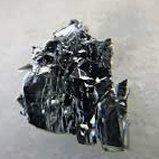| Chemical Composition: |
As |
| Color: |
Silvery white when freshly exposed, dark gray to black when tarnished |
| Hardness: |
3 - 4 |
| Cleavage: |
Perfect in one direction |
| Fracture: |
Uneven |
| Crystal Structure: |
Opague; trigonal |
| Specific Gravity: |
5.4 - 5.9+ |
| Occurence: |
China, Peru, Southwest England, France, Norway, Germany, Italy, Japan, USA |
| Crystal System: |
Hexagonal |
| Cell Salt: |
A native mineral ore, usually with some antimony, iron, nickel, silver, and sulphur |
| Color: |
Tin white, quickly tarnishing to dark gray; evolved specimens are orange-red with a metallic glow |
| Energy: |
Projective |
| Element: |
Air Fire, and Earth |
| Planet/Sign: |
Jupiter/Sagittarius; Mercury/Virgo |
| Stone Lore: |
Arsenic crystal comes from England, France, Germany, and Italy. It has been found in small quantities in Arizona and British Columbia.
***CAUTION: The fumes of arsenic crystal are poisonous, so take care to avoid breathing the fumes. Arsenic is deadly if taken internally. |
| Medicine Uses: |
Despite the potential danger, this stone happens to be an excellent diagnostic tool for getting to the root of disruptive mental and physical conditions. It is especially beneficial when used to overcome inertia. The orange-red colored crystals are the preferred healing stones. |

